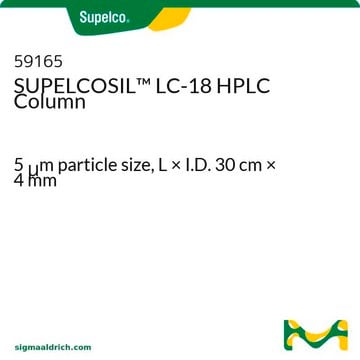The guard column kit for Product No. 565325-U is 565371-U. This kit includes one cartridge, stand-alone holder, a piece of tubing, 2 nuts and 2 ferrules. A set of two replacement cartridges is Product No. 565370-U.
565325-U
Ascentis® RP-Amide (5 µm) HPLC Columns
L × I.D. 25 cm × 4.6 mm, HPLC Column
Synonim(y):
Kolumna do chromatografii w odwróconej fazie RP-Amide
Wybierz wielkość
4110,00 zł
Wybierz wielkość
About This Item
4110,00 zł
Polecane produkty
Nazwa produktu
Ascentis® RP-Amide HPLC Column, 5 μm particle size, L × I.D. 25 cm × 4.6 mm
Materiały
stainless steel column
Poziom jakości
agency
suitable for USP L60
linia produktu
Ascentis®
Właściwości
endcapped
producent / nazwa handlowa
Ascentis®
opakowanie
1 ea of
zakres etykietowania
19.5% Carbon loading
Parametry
≤70 °C temp. range
400 bar pressure (5801 psi)
metody
HPLC: suitable
LC/MS: suitable
dł. × śr. wewn.
25 cm × 4.6 mm
powierzchnia
450 m2/g
pokrycie powierzchni
2.7 μmol/m2
zanieczyszczenia
<5 ppm metals
Matryca
fully porous particle
silica gel high purity, spherical
grupa aktywna macierzy
amide, alkyl phase
wielkość cząstki
5 μm
wielkość porów
100 Å
Zakres roboczy pH
2-8
Zastosowanie
environmental
food and beverages
metoda separacji
reversed phase
Szukasz podobnych produktów? Odwiedź Przewodnik dotyczący porównywania produktów
Powiązane kategorie
Opis ogólny
Ascentis RP-Amide is a new generation ultra low bleed, embedded polar group (EPG) phase that provides orthogonal selectivity and increased resolution for HPLC and LC-MS analysis of polar compounds. The Ascentis RP-Amide is the first choice in embedded polar group HPLC phases.
Zastosowanie
- Zwalidowana metoda UHPLC oznaczania kwasów kawoilochinowego i di-kofeilochinowego w ekstraktach z zielonej kawy przy użyciu kolumny RP-Amide z topionym rdzeniem...: W niniejszym badaniu przedstawiono zwalidowaną metodę ultrawysokosprawnej chromatografii cieczowej (UHPLC) wykorzystującą kolumnę RP-Amide fused-core do ilościowego oznaczania kwasów kawoilochinowego i di-kofeilochinowego w ekstraktach z zielonej kawy. Metoda wykazała doskonałą precyzję, dokładność i czułość, co czyni ją cennym narzędziem do analizy tych bioaktywnych związków w złożonych matrycach. Badania podkreślają użyteczność kolumny 2445 RP-Amide HPLC w zwiększaniu rozdzielczości i wydajności separacji chromatograficznych w zastosowaniach chemii analitycznej (Fibigr et al., 2018).
Cechy i korzyści
- Excellent retention and peak shape for polar compounds
- 100% aqueous compatibility
- Ultra low bleed, LC-MS compatible
- Unique selectivity
Informacje prawne
kartridż do prekolumny
Kod klasy składowania
11 - Combustible Solids
Klasa zagrożenia wodnego (WGK)
WGK 3
Temperatura zapłonu (°F)
Not applicable
Temperatura zapłonu (°C)
Not applicable
Wybierz jedną z najnowszych wersji:
Masz już ten produkt?
Dokumenty związane z niedawno zakupionymi produktami zostały zamieszczone w Bibliotece dokumentów.
Klienci oglądali również te produkty
-
What is the Product No of the guard column for Product No. 565325-U Ascentis RP-Amide HPLC column?
1 answer-
Helpful?
-
-
What solvent should Product No. 565325-U Ascentis RP-Amide HPLC Column be stored in?
1 answer-
Product No. 565325-U should be stored in 100% acetonitrile after any buffers have been flushed out.
Helpful?
-
-
What is the Department of Transportation shipping information for this product?
1 answer-
Transportation information can be found in Section 14 of the product's (M)SDS.To access the shipping information for this material, use the link on the product detail page for the product.
Helpful?
-
-
Can I use Ascentis Express on a UHPLC system?
1 answer-
Yes. Ascentis Express columns are packed in a way making them suitable for these ultra high pressure instruments. In fact, Ascentis Express outperforms sub-2 μm micron columns on many applications since Ascentis Express provides the benefits of sub-2 μm particles but at much lower back pressure. These benefits include the capability of providing fast HPLC and higher resolution chromatography. The Fused-Core particle consists of a 1.7 μm solid core and a 0.5 μm porous shell. A major benefit of the Fused-Core particle is the small diffusion path (0.5 μm) compared to conventional fully porous particles. The shorter diffusion path reduces axial dispersion of solutes and minimizes peak broadening.
Helpful?
-
Active Filters
Nasz zespół naukowców ma doświadczenie we wszystkich obszarach badań, w tym w naukach przyrodniczych, materiałoznawstwie, syntezie chemicznej, chromatografii, analityce i wielu innych dziedzinach.
Skontaktuj się z zespołem ds. pomocy technicznej









